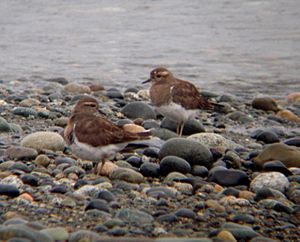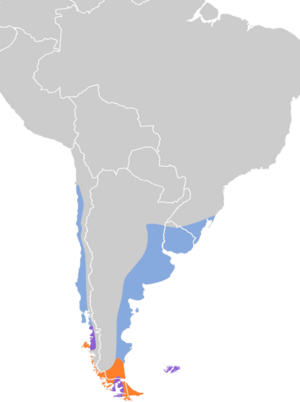Rufous-chested dotterel facts for kids
Quick facts for kids Rufous-chested dotterel |
|
|---|---|
 |
|
| Conservation status | |
| Scientific classification | |
 |
|
| Breeding Resident Non-breeding | |
| Synonyms | |
|
Zonibyx modestus |
The rufous-chested dotterel (Zonibyx modestus) is a cool bird also known as the rufous-chested plover. It belongs to the Charadriidae bird family. You can find this bird in several South American countries. These include Argentina, Brazil, Chile, and Uruguay. It also lives on the Falkland Islands.
Contents
About the Rufous-chested Dotterel
The rufous-chested dotterel is a unique bird. Scientists often place it in its own special group, called Zonibyx. This means it's the only bird in that specific group. This idea became more accepted around 2023.
What Does It Look Like?
This bird is about 19 to 22 centimeters (7.5 to 8.7 inches) long. It weighs between 71 and 94 grams (2.5 to 3.3 ounces). That's about the weight of a small apple!
When males are ready to breed, they look very colorful. They have a gray face with a bright white stripe above their eye. Their throat is gray, and their head is brown. Their chest is a bright reddish-brown color. Below this, they have a black band. The rest of their belly is white. Their back and wings are brown.
Female birds look similar but their colors are a bit softer. When these birds are not breeding, their bright colors fade. The reddish-brown and gray turn into pale brown. Young birds look like non-breeding adults. However, their upper parts and chest are a darker brown.
Where Does It Live?
The rufous-chested dotterel lives in the Falkland Islands. It also lives along the coast and a bit inland in Argentina, Uruguay, and southeastern Brazil. You can also find it in Chile. Sometimes, it flies to Paraguay and Peru, but this is rare.
During the breeding season, these birds like open grasslands. They also live in wet, boggy areas or stony places near lakes. Some prefer coastal areas with small stones. When it's not breeding season, they move to different spots. They can be found in grasslands that are worn down or flooded. They also live in marshes, near streams, and on coastal mudflats. You might see them on beaches or rocky shores too.
How Does It Behave?
Amazing Migrations
The rufous-chested dotterel breeds in southern Chile, Argentina, and the Falkland Islands. Most of these birds travel north for the winter. They can fly as far as northern Chile and southern Brazil. A few even go to Peru and Paraguay. The adult birds start their long journey once their young can take care of themselves.
What Does It Eat?
These birds look for food in grasslands. They also search along the edges of ponds, rivers, and the sea. During breeding season, they often protect a small area where they feed. When it's not breeding time, they often feed in groups. These groups can have 30 or more birds!
Their diet mainly consists of small bugs. This includes adult insects and their young. They also eat small snails and slugs. Sometimes, they eat plant material like algae.
Raising a Family (Reproduction)
The rufous-chested dotterel usually lays its eggs in October and November. On the Falkland Islands, they might start in September. Their nest is a simple dip in the ground. It's often in an open area.
They usually lay two eggs, but sometimes three. Both the mother and father bird take turns sitting on the eggs. This keeps the eggs warm until they hatch. We don't know exactly how long the eggs take to hatch. We also don't know how long it takes for the young birds to be ready to fly.
What Sounds Does It Make?
During the breeding season, the male bird has a special flight display. It makes a long series of short, sharp notes. These are often followed by a rough, drawn-out croak. It sounds like "pic..pic..pic..pic..pic..grrrrrrahr." When they fly, their call is a soft, whistling sound like "wheeerr."
Is It Safe? (Conservation Status)
The IUCN is a group that checks on animals. They have said the rufous-chested dotterel is a species of "Least Concern." This means it's not currently in danger. It lives in a very large area. However, we don't know exactly how many of these birds there are. We also don't know if their numbers are growing or shrinking.
No immediate threats have been found for this bird. People generally think it's quite common. Its home is often in places where humans don't have a big impact. This suggests the bird is likely safe for now.
See also
 In Spanish: Chorlito chileno para niños
In Spanish: Chorlito chileno para niños


